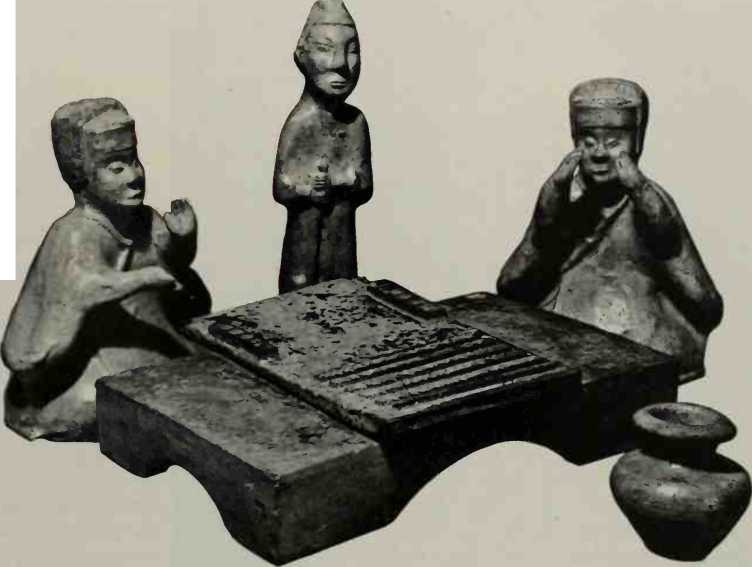ORNATE BRONZE MIRRORS bear myriad cosmological signs and symbols on their backs. In Ancient China
The ancient Chinese believed that if a nation were virtuous. Heaven would shower good fortune upon it. The people, it was thought, would be rewarded with a temperate climate, adequate rainfall and plentiful harvests. If, however, a society had strayed from virtue, it soon would be assailed by calamities such as droughts, floods and famines. Often these natural disasters were regarded as sure signs that the government was corrupt and that the collapse of the dynasty was imminent.
Out of this vision of the workings of nature, the Chinese evolved many symbols for their cosmic beliefs. Often these figures appeared on the backs of bronze mirrors, like those shown at right. The mirrors, which were sometimes worn to protect people from evil spirits, were suspended from the waist on a cord that was threaded through the knob in the center of the design. The square inscribed around the knob stood for the earth. The T shapes at the sides of the square symbolized sacred mountains that were thought to hold up the heavens. The circles beyond these, which enclosed a variety of zodiacal signs, patterns, mythical animals and inscriptions, represented the edges of the universe, and the unknown beyond.
These highly polished mirrors zoere used more often for magical than for practical
Purposes, and they were frequently buried in graves to provide light for the deo

An ancient game, called Liu Po, is played by two gentlemen while a servant looks on in this tableau of Han Dynasty funerary figurines. The rules have been lost to history but each player apparently used six pieces, which he moved around a board; the moves were determined by throwing six sticks.

Highborn Chinese ladies and gentlemen, waited on by corps of servants and slaves, whiled away their leisure in various entertainments. They enjoyed sports, parlor games, music and dancing, and the great seasonal and ceremonial festivals that marked such occasions as the new year—or the emperor's birthday. Some of these amusements were shared by the lowliest common folk. Hunting, for example, was a sport indulged in by everyone. A royal hunt was a grand affair, with beaters, dogs, cheetahs and eagles. But even a lesser nobleman might enjoy a day on the plains with a trained Korean falcon, and a commoner could take his goshawk into the forest with the hope of adding a hare or pheasant to the family pot.
There were other active sports, including a kind of football that had been popular since antiquity and that was regarded as a useful military exercise. In T'ang times, emperors, courtiers, scholars and even ladies enjoyed the game of polo, which had been introduced not long before from Iranian lands. Persian horses from Iran were in fact greatly prized in China by polo players, soldiers and sportive aristocrats. Brought to China in Han times when the Han armies opened the west, and attached to the emperor's stables to augment the royal herd of Mongolian ponies, Iranian horses had a special glamor and were known as "dragon horses" or "horses of heaven." T'ang poetry is full of allusions to them.
Among the less active sports were board and table games, some of which were distantly related to modern Parcheesi, lotto and backgammon. One very ancient and very popular board game, now becoming known to Americans under its Japanese name of "go," had overtones of military strategy. Playing cards are also thought to be a Chinese invention of the T'ang period.
Dancing was inseparable from life, religion and all ceremonial acts. The ancient kings had danced
To appease the drought demons of Shang times, and in the time of Confucius, troupes of barbarian dancers twirling yak tails and wands tipped with pheasant feathers performed in the courts of the kings to drive away evil spirits. Some magical dances such as these were still being performed in the courts of the emperors of T'ang, but, by medieval times, there were also dances that were performed purely for the entertainment of sophisticated audiences. The wild galops of the Turks and the Iranians delighted upper-class T'ang gatherings. Another extremely popular dance was the specialty of Sogdian twirling girls; they performed it on the tops of large rolling balls while attired in costumes of green pantaloons and crimson robes.
Music, an inseparable part of dancing, was at the same time considered a much more serious pursuit. The Chinese men had always believed that music had mystical and moral properties. Confucius and his followers held that certain kinds of music were elevating and purifying, while others led to corruption and depravity. Accordingly, music was put high on the list of required subjects in the education of gentlemen.
The most holy and venerable of musical instruments, revered perhaps even beyond the great bronze bells that rang in court and temple, were sets of stone chimes—triangular pieces of limestone that were suspended in racks and struck with batons. These were sounded in the sacred orchestras of Shang, and were still being played in the classical ensembles of T'ang. Drums, bells and flutes were also ancient and respected instruments. Stringed instruments were less highly regarded, except for a certain kind of zither, the music of which was thought to be especially suitable to the meditations of respectable gentlemen. Harps and lutes, which became very popular after their introduction from western Asia in Han times, were generally used on informal, relaxed occasions. A unique instrument was the sheng, a kind of mouth organ made by inserting a set of canes into a gourd; apparently it originated among the peoples of Indochina. It found its way to Europe in the 18th Century and influenced the development of organs, harmonicas and accordions.
Music and dancing formed the core of the most colorful and exciting of all entertainments—the great palace-shows, such as might be given on the occasion of an imperial birthday. At celebrations of the emperor's birthday in the early Eighth Century, the festivities were enlivened by a troop of a hundred dancing horses adorned with rich silks and precious stones and metals. They danced with tossing heads to popular tunes played by the palace orchestra. On the same occasions there were also displays of the tricks of foreign magicians, musical performances by bands of richly dressed palace girls and parades of elephants and rhinoceroses.
In addition to such special national celebrations, there were the eternal but ever-changing seasonal festivals, made meaningful by ancient beliefs, in which the lowliest clodhopper could find occasions for joy and the reaffirmation of faith. The end of winter and the beginning of spring, for instance, signalizing every sort of spiritual and physical renewal, each produced a series of festivals, including salutations to the local earth-gods and mating and fertility rites. The whole cycle of months had a corresponding sequence of holidays, such as the brilliant street illuminations during the first month. After the introduction of Buddhism in the First Century, there were also outdoor spectacles, subsidized by the great monasteries of the major cities, portraying episodes in the history of that faith for the edification of the public.
These festive rites and gay celebrations, enjoyed by the people of all classes, were the bonds that crossed the division of society and united all Chinese into one great civilization.




 World History
World History









